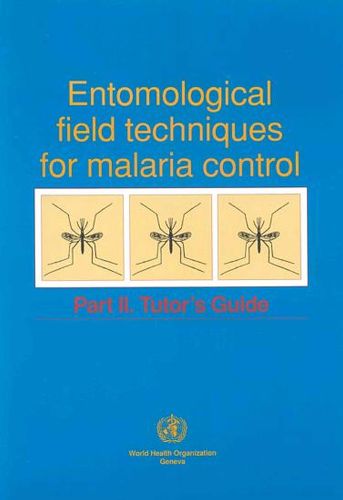Readings Newsletter
Become a Readings Member to make your shopping experience even easier.
Sign in or sign up for free!
You’re not far away from qualifying for FREE standard shipping within Australia
You’ve qualified for FREE standard shipping within Australia
The cart is loading…






One of two spiral-bound manuals which provide a practical training module covering virtually all field techniques needed for the collection and transportation of mosquitos as part of a malaria control programme. The manuals, which can be used to train health workers having no previous experience in entomology or malaria control, are intended to form the backbone of a training programme lasting from three to four weeks. The first manual, which is addressed to learners, provides step-by-step instructions in the field work needed to secure comprehensive information about the mosquito population in a given area. Information is presented in a series of 13 illustrated learning units, moving from the simplest collecting techniques that can be practised in the laboratory to more sophisticated procedures that must be undertaken in the field. Techniques covered include hand collection methods, indoor collection after pyrethrin spraying, direct catches of mosquitos from animal and human bait, and collection of larvae and pupae from breeding sites. To help build competence, learning units deal with the theory underlying each task as well as with the practical skills required. Other units help readers learn how to identify species at all stages of the life-cycle, keep accurate records, and preserve and transport specimens under strictly controlled conditions. The need to gain the cooperation of the community is also thoroughly explained. The second manual, addressed to tutors, offers practical advice on the organization and running of training courses. Like the first manual, the Tutor’s Guide is divided into a series of learning units, each with clearly specified learning objectives. Information is provided on the equipment needed for teaching a particular topic or demonstrating a particular technique, and on any support services that may be required. Each unit offers guidance on appropriate teaching methods, with more detailed suggestions supplied in an annex. The manual also reproduces model forms for appraising the performance of individual tasks and provides advice on how to give participants feedback on their progress. The manual concludes with a model questionnaire that can be used to evaluate the effectiveness of the course.
$9.00 standard shipping within Australia
FREE standard shipping within Australia for orders over $100.00
Express & International shipping calculated at checkout
One of two spiral-bound manuals which provide a practical training module covering virtually all field techniques needed for the collection and transportation of mosquitos as part of a malaria control programme. The manuals, which can be used to train health workers having no previous experience in entomology or malaria control, are intended to form the backbone of a training programme lasting from three to four weeks. The first manual, which is addressed to learners, provides step-by-step instructions in the field work needed to secure comprehensive information about the mosquito population in a given area. Information is presented in a series of 13 illustrated learning units, moving from the simplest collecting techniques that can be practised in the laboratory to more sophisticated procedures that must be undertaken in the field. Techniques covered include hand collection methods, indoor collection after pyrethrin spraying, direct catches of mosquitos from animal and human bait, and collection of larvae and pupae from breeding sites. To help build competence, learning units deal with the theory underlying each task as well as with the practical skills required. Other units help readers learn how to identify species at all stages of the life-cycle, keep accurate records, and preserve and transport specimens under strictly controlled conditions. The need to gain the cooperation of the community is also thoroughly explained. The second manual, addressed to tutors, offers practical advice on the organization and running of training courses. Like the first manual, the Tutor’s Guide is divided into a series of learning units, each with clearly specified learning objectives. Information is provided on the equipment needed for teaching a particular topic or demonstrating a particular technique, and on any support services that may be required. Each unit offers guidance on appropriate teaching methods, with more detailed suggestions supplied in an annex. The manual also reproduces model forms for appraising the performance of individual tasks and provides advice on how to give participants feedback on their progress. The manual concludes with a model questionnaire that can be used to evaluate the effectiveness of the course.